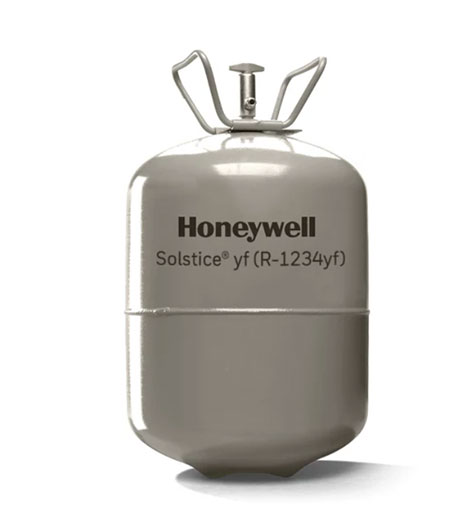Energy efficient, low-global warming potential refrigerant keeps passengers and batteries cool while reducing battery power drain.
As electric vehicle driving range continues to improve, more drivers feel comfortable taking to the road in electric vehicles (EVs). Most new EVs can travel more than 250 miles on a single charge, with some reaching greater than 350 miles of range. Factors such as road conditions, driving style, vehicle load and ambient temperature can affect actual range performance.
Automakers are responding to quickly increasing consumer demand for electric vehicles by introducing many new models in all segments in the United States and Europe. With every new model introduction, carmakers are looking for ways to improve the driving range of their vehicles and reduce range anxiety so that more consumers will buy their EV offerings.
Charging away from home has become more accessible, with fast-charging Level 3 stations now available at many highway rest stops, malls, restaurants and markets, but research continues to show that “range anxiety” is still among the top reasons consumers hesitate in making the switch to EVs. Batteries themselves have been a primary focus for improving performance as well.
Now, as EV makers continue their efforts to reduce the battery power drain that can happen while driving, they’re looking for solutions to most effectively cool and heat cabins, motors and batteries—a particular challenge for EV makers.
Estimates are that 52% of the new cars sold in the United States by 2030 will be EVs. As a result, automakers are working furiously to introduce appealing, cost-effective new EV models in every segment including subcompact cars and sport utility vehicles (SUVs). Size, equipment and price points vary greatly from one model to another, but all EVs face a common challenge—finding ways to extend the driving range.
Internal combustion engine (ICE) vehicles typically cool the passenger cabin with a belt driven compressor and other heating, ventilation and air conditioning (HVAC) components that enable a refrigerant to absorb heat from the passenger cabin as it moves between a liquid and gaseous state, creating a cooling effect. The compressor is powered by the engine. When temperatures drop in the fall and winter, the vehicle uses recovered heat from the engine to heat the cabin.
Since EVs do not have internal combustion engines, they need another way to power the air conditioning compressor and generate heat in winter. Electric compressors and electric heaters draw power from the EV’s main battery pack which impacts the vehicle’s range.
Extreme temperatures can wreak havoc on EV batteries, making thermal management critical. Batteries operate most efficiently when the mercury is between 68°F and 95°F (20°C and 35°C). Low temperatures reduce the speed of the chemical reactions that enable the battery to release stored energy. In fact, battery life can be impacted by as much as 40% in sub-freezing weather.
At high temperatures, using the air conditioner to cool the cabin is also a drain on the battery and can reduce range by about 17%, according to an AAA study. Extreme temperatures can cause a battery or motor failure, affect charging time, reduce battery life-expectancy or, in rare circumstances, cause the battery to catch fire.
All this points to a need to develop new thermal management systems that minimize power consumption while providing thermal control of the cabin and electronic components. One newer technology that is being used more and more in light EVs is a heat pump, which can make both cold and warm air for cabin occupants. This technology is similar to how heat pumps work in homes and commercial buildings. In the case of an efficient automotive heat pump, enough cooling or heating power can be generated to control the temperature of the cabin, plus the batteries and electronics. By using a heat pump instead of a conventional electric heater, the range of the EV can be improved.
In addition to solving the heating and cooling dilemma, EV makers face another challenge. A global phasedown of high-global-warming-potential (GWP) materials called hydrofluorocarbons (HFCs) is requiring automakers to transition to lower-GWP solutions. Spurred by changing regulatory requirements and public opinion, the predominant refrigerant used in the past, HFC-134a, must be replaced with low-GWP alternatives.
The most globally available and proven solution for this application is HFO-1234yf, an ultra-low GWP refrigerant found today in almost all light vehicles made for sale in the United States and Europe.

Honeywell was the first to make HFO-1234yf available to automobile manufacturers a decade ago and was also the first to build a world scale HFO-1234yf manufacturing plant in the United States. Honeywell’s Solstice® 1234yf has proven that it has the best balance of overall properties allowing thermal optimization in EVs. EV heat pumps that run on Solstice 1234yf can cool motors, batteries and other electronic components, as well as heat and cool the cabin.
Development of next generation thermal management solutions like those being deployed in EV models today took years to design and integrate, and also required significant investments by Tier 1 auto suppliers and by auto manufacturers themselves. Fortunately for the car industry, Honeywell’s Solstice 1234yf was available when EV development began about 10 years ago and continues to offer the optimal set of thermal properties to efficiently heat and cool EVs. There is opportunity to continue innovating in this field, and Solstice 1234yf is a solution that is ready-now to support further development in the EV industry.

Rick Winick – Vice President and General Manager, Honeywell Automotive Refrigerants
Scott Ellyson, CEO of East West Manufacturing, brings decades of global manufacturing and supply chain leadership to the conversation. In this episode, he shares practical insights on scaling operations, navigating complexity, and building resilient manufacturing networks in an increasingly connected world.